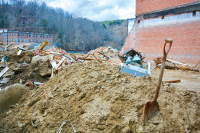Flagging tourism prompts Jackson to hike room tax
Tourists staying in Jackson County will pay more on their hotel bills starting Jan. 1. Commissioners this week hiked the tax from 3 to 6 cents, the highest room tax rate allowed by state law.
“If this money is spent wisely, I think it might be a good thing,” Dillsboro Inn owner T.J. Walker said Tuesday. “I’m not against it — but I’m not aware of it enough to be for it, either.”
Jackson County will have twice the room tax of most Western North Carolina counties, which largely set the rate at 3 percent. Haywood and Buncombe have 4 percent, Henderson has 5 percent. Only the town of Franklin has a room tax of 6 percent, though outside the town limits in the rest of Macon County it is only 3 percent.
Jackson County commissioners approved the room tax hike this week in a 4-1 vote, with Commissioner Mark Jones of Cashiers casting the lone no vote.
This summer, Jackson County received authorization from the state legislature to increase its room tax up to 6 percent, but had to vote to enact it.
Before voting, county leaders reviewed tourism-related information about neighboring counties. It shows Swain County is leading the pack, with 3,210 tourism-related jobs compared to 560 in Jackson County — a difference likely accounted for by the Nantahala Gorge outdoor scene and Harrah’s Cherokee casino.
Related Items
Jackson County, like most counties, has seen a decline in room tax collection rates with the recession; starting about four years ago. The past couple of years, room tax collections have been rebounding, but Jackson seems to have faired worse than its neighbors, with bigger drops and a weaker rebound.
“We need to redouble our efforts to attract tourists to Jackson County,” Commissioner Doug Cody said. “Anything we make off tourism helps relieve pressure off of property taxes … these are taxes tourists pay. The citizens of Jackson County will not be burdened with another tax.”
Commissioner Charles Elders described the numbers that show Jackson lagging “troubling.”
Jones, who chairs the Cashiers Area Travel and Tourism, did not specify exactly why he voted against the tax increase. But he did caution his fellow commissioners that “I hope the intent of these monies is to stay within the original intent,” that is, to market and promote tourism.
New state language in the law, Jones said, allows “it to be piggybacked on, it allows for hardscapes — as long as it promotes tourism.” Historically, room tax — under state law — had to be spent on tourism promotion. Now, it can be spent on “tourism-related” developments, which could include sports fields to attract tournaments, greenways or festival venues.
County Manager Chuck Wooten said the original 1987 resolution by Jackson County authorizing a room tax would need modifying before any actions except promotion could take place.
“We don’t have to decide that right now,” Chairman Jack Debnam said.
The formula for distributing the additional room tax is unclear. Currently, 75 percent of room tax collected in Cashiers is used exclusively by Cashiers to promote that area rather than the county as a whole. The rest of the room tax is managed by the countywide Jackson County Travel and Tourism Authority, a public body.
Current tax rates
Haywood County 4 percent
Jackson County 3 percent
Macon County 3 percent, plus town of Franklin imposes an additional 3 percent
Swain County 3 percent
Collection rate comparison
Jackson County
• 2006-2007 $506,574.48
• 2007-2008 $506,004.53
• 2008-2009 $429,378.27
• 2009-2010 $413,939.07
• 2010-2011 $446,339.59
Swain County
• 2006-2007 $305,352
• 2007-2008 $320,820
• 2008-2009 $309,802
• 2009-2010 $335,353
• 2010-2011 $352,437
Haywood County
• 2006-2007 $935,000
• 2007-2008 $1.04 million
• 2008-2009 $954,000
• 2009-2010 $891,000
• 2010-2011 $962,500
Tourism rebound
Tourism spending is on the rise after three years of stagnation and decline. The North Carolina Division of Tourism, Development conducts an economic impact study every year. It uses the industry standard “Travel Economic Impact Model” to measure the impact of travel, a disaggregated model that looks at everything from lodging and food to retail and recreation. Here’s a decade’s worth of those tourism economic impact numbers.
Haywood
2000 99.9 million
2001 97.7 million
2002 97.8 million
2003 95.9 million
2004 97.69 million
2005 103.4 million
2006 111 million
2007 116.6 million
2008 113.6 million
2009 108.9 million
2010 116.3 million
Jackson
2000 50.5 million
2001 50.1 million
2002 53.6 million
2003 53.5 million
2004 55.7 million
2005 61.7 million
2006 68.2 million
2007 72.6 million
2008 69 million
2009 60 million
2010 62.5 million
Macon
2000 89.7 million
2001 81.1 million
2002 89.8 million
2003 85.9 million
2004 92.2 million
2005 102.5 million
2006 111.1 million
2007 115.4 million
2008 120.5 million
2009 114.5 million
2010 122.1 million
Swain (includes Cherokee)
2000 N/A
2001 199.2 million
2002 214.8 million
2003 216.8 million
2004 213.5 million
2005 222 million
2006 240.8 million
2007 251 million
2008 233.3 million
2009 237.3 million
2010 256.3 million
Jobs directly related to tourism for 2010
Haywood 1,300
Jackson 560
Macon 1,120
Swain (includes Cherokee) 3,210









